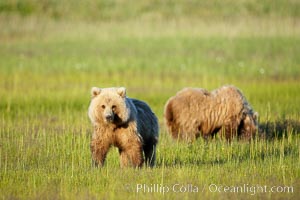
Juvenile brown bears near Johnson River. Before reaching adulthood and competition for mating, it is common for juvenile brown bears to seek one another for companionship after leaving the security of their mothers.
Species: Brown bear, Ursus arctos
Location: Johnson River, Lake Clark National Park, Alaska
Image ID: 19171
Species: Brown bear, Ursus arctos
Location: Johnson River, Lake Clark National Park, Alaska
Image ID: 19171

Elephants sparring with tusks.
Species: African elephant, Loxodonta africana
Location: Amboseli National Park, Kenya
Image ID: 29492
Species: African elephant, Loxodonta africana
Location: Amboseli National Park, Kenya
Image ID: 29492

Elephants sparring with tusks.
Species: African elephant, Loxodonta africana
Location: Amboseli National Park, Kenya
Image ID: 29490
Species: African elephant, Loxodonta africana
Location: Amboseli National Park, Kenya
Image ID: 29490

Elephants sparring with tusks.
Species: African elephant, Loxodonta africana
Location: Amboseli National Park, Kenya
Image ID: 29491
Species: African elephant, Loxodonta africana
Location: Amboseli National Park, Kenya
Image ID: 29491
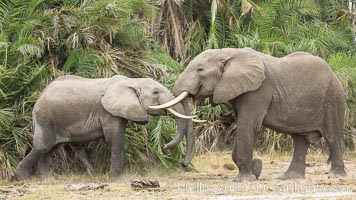
Elephants sparring with tusks.
Species: African elephant, Loxodonta africana
Location: Amboseli National Park, Kenya
Image ID: 29545
Species: African elephant, Loxodonta africana
Location: Amboseli National Park, Kenya
Image ID: 29545

Elephants sparring with tusks.
Species: African elephant, Loxodonta africana
Location: Amboseli National Park, Kenya
Image ID: 29547
Species: African elephant, Loxodonta africana
Location: Amboseli National Park, Kenya
Image ID: 29547
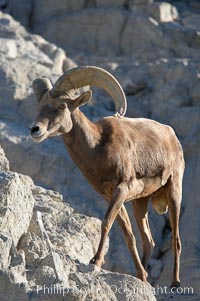
Desert bighorn sheep, male ram. The desert bighorn sheep occupies dry, rocky mountain ranges in the Mojave and Sonoran desert regions of California, Nevada and Mexico. The desert bighorn sheep is highly endangered in the United States, having a population of only about 4000 individuals, and is under survival pressure due to habitat loss, disease, over-hunting, competition with livestock, and human encroachment.
Species: Desert bighorn sheep, Ovis canadensis nelsoni
Image ID: 14651
Species: Desert bighorn sheep, Ovis canadensis nelsoni
Image ID: 14651

Desert bighorn sheep, young/immature male ram. The desert bighorn sheep occupies dry, rocky mountain ranges in the Mojave and Sonoran desert regions of California, Nevada and Mexico. The desert bighorn sheep is highly endangered in the United States, having a population of only about 4000 individuals, and is under survival pressure due to habitat loss, disease, over-hunting, competition with livestock, and human encroachment.
Species: Desert bighorn sheep, Ovis canadensis nelsoni
Image ID: 14652
Species: Desert bighorn sheep, Ovis canadensis nelsoni
Image ID: 14652
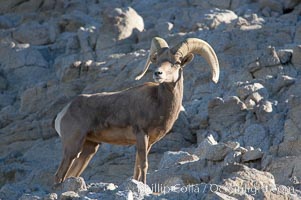
Desert bighorn sheep, male ram. The desert bighorn sheep occupies dry, rocky mountain ranges in the Mojave and Sonoran desert regions of California, Nevada and Mexico. The desert bighorn sheep is highly endangered in the United States, having a population of only about 4000 individuals, and is under survival pressure due to habitat loss, disease, over-hunting, competition with livestock, and human encroachment.
Species: Desert bighorn sheep, Ovis canadensis nelsoni
Image ID: 14653
Species: Desert bighorn sheep, Ovis canadensis nelsoni
Image ID: 14653

Desert bighorn sheep, male ram. The desert bighorn sheep occupies dry, rocky mountain ranges in the Mojave and Sonoran desert regions of California, Nevada and Mexico. The desert bighorn sheep is highly endangered in the United States, having a population of only about 4000 individuals, and is under survival pressure due to habitat loss, disease, over-hunting, competition with livestock, and human encroachment.
Species: Desert bighorn sheep, Ovis canadensis nelsoni
Image ID: 14654
Species: Desert bighorn sheep, Ovis canadensis nelsoni
Image ID: 14654

Desert bighorn sheep, male ram. The desert bighorn sheep occupies dry, rocky mountain ranges in the Mojave and Sonoran desert regions of California, Nevada and Mexico. The desert bighorn sheep is highly endangered in the United States, having a population of only about 4000 individuals, and is under survival pressure due to habitat loss, disease, over-hunting, competition with livestock, and human encroachment.
Species: Desert bighorn sheep, Ovis canadensis nelsoni
Image ID: 14655
Species: Desert bighorn sheep, Ovis canadensis nelsoni
Image ID: 14655

Desert bighorn sheep, male ram and female ewe. The desert bighorn sheep occupies dry, rocky mountain ranges in the Mojave and Sonoran desert regions of California, Nevada and Mexico. The desert bighorn sheep is highly endangered in the United States, having a population of only about 4000 individuals, and is under survival pressure due to habitat loss, disease, over-hunting, competition with livestock, and human encroachment.
Species: Desert bighorn sheep, Ovis canadensis nelsoni
Image ID: 14656
Species: Desert bighorn sheep, Ovis canadensis nelsoni
Image ID: 14656

Desert bighorn sheep, young/immature male ram. The desert bighorn sheep occupies dry, rocky mountain ranges in the Mojave and Sonoran desert regions of California, Nevada and Mexico. The desert bighorn sheep is highly endangered in the United States, having a population of only about 4000 individuals, and is under survival pressure due to habitat loss, disease, over-hunting, competition with livestock, and human encroachment.
Species: Desert bighorn sheep, Ovis canadensis nelsoni
Image ID: 14657
Species: Desert bighorn sheep, Ovis canadensis nelsoni
Image ID: 14657

Desert bighorn sheep, male ram. The desert bighorn sheep occupies dry, rocky mountain ranges in the Mojave and Sonoran desert regions of California, Nevada and Mexico. The desert bighorn sheep is highly endangered in the United States, having a population of only about 4000 individuals, and is under survival pressure due to habitat loss, disease, over-hunting, competition with livestock, and human encroachment.
Species: Desert bighorn sheep, Ovis canadensis nelsoni
Image ID: 14658
Species: Desert bighorn sheep, Ovis canadensis nelsoni
Image ID: 14658

Desert bighorn sheep, female ewe. The desert bighorn sheep occupies dry, rocky mountain ranges in the Mojave and Sonoran desert regions of California, Nevada and Mexico. The desert bighorn sheep is highly endangered in the United States, having a population of only about 4000 individuals, and is under survival pressure due to habitat loss, disease, over-hunting, competition with livestock, and human encroachment.
Species: Desert bighorn sheep, Ovis canadensis nelsoni
Image ID: 14659
Species: Desert bighorn sheep, Ovis canadensis nelsoni
Image ID: 14659

Desert bighorn sheep, male ram. The desert bighorn sheep occupies dry, rocky mountain ranges in the Mojave and Sonoran desert regions of California, Nevada and Mexico. The desert bighorn sheep is highly endangered in the United States, having a population of only about 4000 individuals, and is under survival pressure due to habitat loss, disease, over-hunting, competition with livestock, and human encroachment.
Species: Desert bighorn sheep, Ovis canadensis nelsoni
Image ID: 14660
Species: Desert bighorn sheep, Ovis canadensis nelsoni
Image ID: 14660
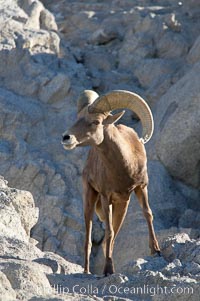
Desert bighorn sheep, male ram. The desert bighorn sheep occupies dry, rocky mountain ranges in the Mojave and Sonoran desert regions of California, Nevada and Mexico. The desert bighorn sheep is highly endangered in the United States, having a population of only about 4000 individuals, and is under survival pressure due to habitat loss, disease, over-hunting, competition with livestock, and human encroachment.
Species: Desert bighorn sheep, Ovis canadensis nelsoni
Image ID: 14661
Species: Desert bighorn sheep, Ovis canadensis nelsoni
Image ID: 14661

Desert bighorn sheep, male ram. The desert bighorn sheep occupies dry, rocky mountain ranges in the Mojave and Sonoran desert regions of California, Nevada and Mexico. The desert bighorn sheep is highly endangered in the United States, having a population of only about 4000 individuals, and is under survival pressure due to habitat loss, disease, over-hunting, competition with livestock, and human encroachment.
Species: Desert bighorn sheep, Ovis canadensis nelsoni
Image ID: 14662
Species: Desert bighorn sheep, Ovis canadensis nelsoni
Image ID: 14662

Desert bighorn sheep, male ram and female ewe. The desert bighorn sheep occupies dry, rocky mountain ranges in the Mojave and Sonoran desert regions of California, Nevada and Mexico. The desert bighorn sheep is highly endangered in the United States, having a population of only about 4000 individuals, and is under survival pressure due to habitat loss, disease, over-hunting, competition with livestock, and human encroachment.
Species: Desert bighorn sheep, Ovis canadensis nelsoni
Image ID: 14663
Species: Desert bighorn sheep, Ovis canadensis nelsoni
Image ID: 14663

Desert bighorn sheep, male ram and female ewe. The desert bighorn sheep occupies dry, rocky mountain ranges in the Mojave and Sonoran desert regions of California, Nevada and Mexico. The desert bighorn sheep is highly endangered in the United States, having a population of only about 4000 individuals, and is under survival pressure due to habitat loss, disease, over-hunting, competition with livestock, and human encroachment.
Species: Desert bighorn sheep, Ovis canadensis nelsoni
Image ID: 14664
Species: Desert bighorn sheep, Ovis canadensis nelsoni
Image ID: 14664

Desert bighorn sheep, male ram. The desert bighorn sheep occupies dry, rocky mountain ranges in the Mojave and Sonoran desert regions of California, Nevada and Mexico. The desert bighorn sheep is highly endangered in the United States, having a population of only about 4000 individuals, and is under survival pressure due to habitat loss, disease, over-hunting, competition with livestock, and human encroachment.
Species: Desert bighorn sheep, Ovis canadensis nelsoni
Image ID: 14665
Species: Desert bighorn sheep, Ovis canadensis nelsoni
Image ID: 14665
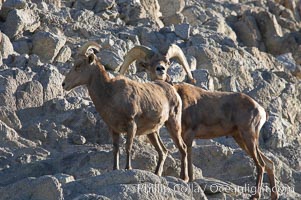
Desert bighorn sheep, male ram and female ewe. The desert bighorn sheep occupies dry, rocky mountain ranges in the Mojave and Sonoran desert regions of California, Nevada and Mexico. The desert bighorn sheep is highly endangered in the United States, having a population of only about 4000 individuals, and is under survival pressure due to habitat loss, disease, over-hunting, competition with livestock, and human encroachment.
Species: Desert bighorn sheep, Ovis canadensis nelsoni
Image ID: 14666
Species: Desert bighorn sheep, Ovis canadensis nelsoni
Image ID: 14666

Desert bighorn sheep, female ewe. The desert bighorn sheep occupies dry, rocky mountain ranges in the Mojave and Sonoran desert regions of California, Nevada and Mexico. The desert bighorn sheep is highly endangered in the United States, having a population of only about 4000 individuals, and is under survival pressure due to habitat loss, disease, over-hunting, competition with livestock, and human encroachment.
Species: Desert bighorn sheep, Ovis canadensis nelsoni
Image ID: 14667
Species: Desert bighorn sheep, Ovis canadensis nelsoni
Image ID: 14667
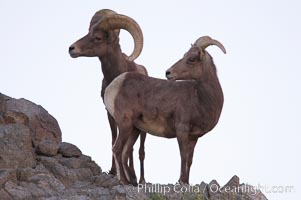
Desert bighorn sheep, male ram and female ewe. The desert bighorn sheep occupies dry, rocky mountain ranges in the Mojave and Sonoran desert regions of California, Nevada and Mexico. The desert bighorn sheep is highly endangered in the United States, having a population of only about 4000 individuals, and is under survival pressure due to habitat loss, disease, over-hunting, competition with livestock, and human encroachment.
Species: Desert bighorn sheep, Ovis canadensis nelsoni
Image ID: 14668
Species: Desert bighorn sheep, Ovis canadensis nelsoni
Image ID: 14668

Desert bighorn sheep, male ram. The desert bighorn sheep occupies dry, rocky mountain ranges in the Mojave and Sonoran desert regions of California, Nevada and Mexico. The desert bighorn sheep is highly endangered in the United States, having a population of only about 4000 individuals, and is under survival pressure due to habitat loss, disease, over-hunting, competition with livestock, and human encroachment.
Species: Desert bighorn sheep, Ovis canadensis nelsoni
Image ID: 14669
Species: Desert bighorn sheep, Ovis canadensis nelsoni
Image ID: 14669

Desert bighorn sheep, young/immature male ram. The desert bighorn sheep occupies dry, rocky mountain ranges in the Mojave and Sonoran desert regions of California, Nevada and Mexico. The desert bighorn sheep is highly endangered in the United States, having a population of only about 4000 individuals, and is under survival pressure due to habitat loss, disease, over-hunting, competition with livestock, and human encroachment.
Species: Desert bighorn sheep, Ovis canadensis nelsoni
Image ID: 14670
Species: Desert bighorn sheep, Ovis canadensis nelsoni
Image ID: 14670

Desert bighorn sheep, male ram. The desert bighorn sheep occupies dry, rocky mountain ranges in the Mojave and Sonoran desert regions of California, Nevada and Mexico. The desert bighorn sheep is highly endangered in the United States, having a population of only about 4000 individuals, and is under survival pressure due to habitat loss, disease, over-hunting, competition with livestock, and human encroachment.
Species: Desert bighorn sheep, Ovis canadensis nelsoni
Image ID: 14671
Species: Desert bighorn sheep, Ovis canadensis nelsoni
Image ID: 14671

Desert bighorn sheep, male ram. The desert bighorn sheep occupies dry, rocky mountain ranges in the Mojave and Sonoran desert regions of California, Nevada and Mexico. The desert bighorn sheep is highly endangered in the United States, having a population of only about 4000 individuals, and is under survival pressure due to habitat loss, disease, over-hunting, competition with livestock, and human encroachment.
Species: Desert bighorn sheep, Ovis canadensis nelsoni
Image ID: 14672
Species: Desert bighorn sheep, Ovis canadensis nelsoni
Image ID: 14672

Desert bighorn sheep, male ram. The desert bighorn sheep occupies dry, rocky mountain ranges in the Mojave and Sonoran desert regions of California, Nevada and Mexico. The desert bighorn sheep is highly endangered in the United States, having a population of only about 4000 individuals, and is under survival pressure due to habitat loss, disease, over-hunting, competition with livestock, and human encroachment.
Species: Desert bighorn sheep, Ovis canadensis nelsoni
Image ID: 14673
Species: Desert bighorn sheep, Ovis canadensis nelsoni
Image ID: 14673

Desert bighorn sheep, male ram. The desert bighorn sheep occupies dry, rocky mountain ranges in the Mojave and Sonoran desert regions of California, Nevada and Mexico. The desert bighorn sheep is highly endangered in the United States, having a population of only about 4000 individuals, and is under survival pressure due to habitat loss, disease, over-hunting, competition with livestock, and human encroachment.
Species: Desert bighorn sheep, Ovis canadensis nelsoni
Image ID: 14674
Species: Desert bighorn sheep, Ovis canadensis nelsoni
Image ID: 14674